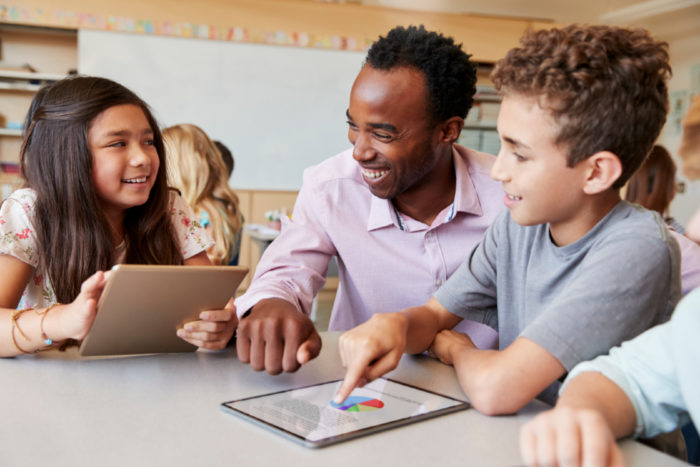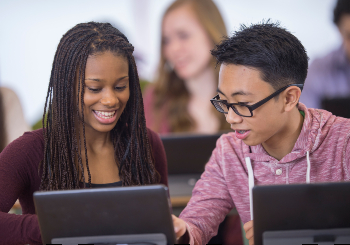
The COVID-19 pandemic, along with the increased attention to racial violence and the Black Lives Matter protests, have continued to emphasize the myriad ways that racial and economic disparities intersect in healthcare, housing, employment and education. Yet despite increased awareness of how these systems converge to create barriers for Black, Latinx and indigenous students, public schools are still expected to be the great equalizer. As the nation moved to online education—better known by many educators as “emergency remote teaching” - we witnessed how these historic and persistent inequalities were magnified in real-time.
As researchers of computer science education and supporters of the BLM movement, one might expect that we’re “all in” with technology because of the ways that it can document injustice and support community activism, especially during a pandemic. There are other benefits of online learning, especially for reaching students in rural communities and for some students with disabilities. However, we also understand how technology has perpetuated biases and limited opportunities for students—which has contributed to the underrepresentation of students of color and girls in computer science.
Online education has been a necessary tactic to get us through the pandemic, but if we really value quality and equity-minded education, it’s important to recognize its limitations.
Many school districts have leaned into addressing various inequalities that emerged in the first days of shut down, such as providing students with devices and wifi access at home, as well as supporting families with food and other necessities. But despite these herculean efforts to meet families’ basic needs, inequities still persist.
Parents and caregivers—emotionally and financially spinning—have been thrust into the role of assistant teachers while juggling the needs of multiple children, their own work, or job loss. And, as adults are risking their health as essential workers in hospitals, supermarkets, and as delivery drivers, many are unable to support their children’s studies. On top of all this, many parents and teachers put everything on hold to join in protest—while socially distancing—against police brutality and violence against Black people.
Students who are caring for elderly or younger family members are having trouble participating online. Others do not have a quiet well-lit space in their homes. Many parents and students are experiencing emotional trauma and anxiety. Yet all students are expected to stay engaged while staring at a screen, separated from their school community.

Meanwhile, teachers are stretched thin, being called upon to create, motivate, and support their students with online curricula, all while caring for their own families during this time of crisis. Given all that is known now, how will schooling in the future address the impact of different home situations? How will schooling respond to the larger political and social context that is deeply affecting our students?
Many school districts have recognized that teachers need extra support to adapt to online teaching environments and improve their capacity to deliver online instruction. For instance, LAUSD launched its Future Ready Certification program for 14,000 staff members. Recognizing the ways in which equity and access issues resurface in online education, they designed this program to prepare educators to provide all students with engaging, student-focused, high-quality instruction encompassing effective online teaching and learning practices.
We applaud these efforts, yet here is where we think our research on student engagement in high school computer science classrooms can be particularly illuminating.
We have seen that technology is a tool for learning, but it alone is not the magic cure for engaging students with a meaningful education.
Engaged learning happens because of good teaching that includes the caring human-to-human interactions when teachers really know their students, have respectful relationships with them and make pedagogical moves that motivate and support student engagement with academic material. Engaged learning transpires when authentic connections are made between academic content and the real social, political, and community issues happening in our world that youth care about.
From our research in LAUSD public school computer science classrooms, we found that students choose to engage when:

These pedagogical efforts are dependent on teachers being able to physically walk around a room to check-in with students when they seem stuck or down, making eye-contact one-on-one, sharing a gentle smile, or sitting next to a student and quietly asking about how their day is going while looking over a project they’re working on.
Understanding students’ perspectives and engagement with the world around them and desires to change their worlds often emerge in side conversations as teachers and students get to know one another. These gestures of care that help build a supportive classroom community of peers are difficult to show on current online platforms. This is especially true when students cannot even show up to online meetings to begin with because they are experiencing incredible stress in their daily lives.
The critical ingredients to an engaging K-12 education are now—and always have been—relationships between students and teachers who know their subject matter, know their students, families, and communities, and can make education meaningful for students’ lives.
Professional development investments need to support educators in getting to know their students by creating more humanizing and culturally responsive learning experiences both in-person and online.
Research about online learning raises some red flags for K-12 education. Studies comparing online and in-person learning reveal that students who do best in online environments are those who have developed time-management skills, are self-motivated, and are already comfortable with technology to the point that they can troubleshoot issues as they arise. This is not the majority of students.
As the world adjusts to the increasing demands of sheltering in place while also responding to and taking action against systemic racism, we cannot let go of the promise that we will return to a future of education that will include human contact in physical classrooms. Yet, we fear there are those who will use this crisis as an opportunity to elevate online learning over brick and mortar schools, while justifying disinvestment in public education. Others will seek to monetize online education and see it only as a business venture, contrary to education being the cornerstone of our democracy.
But, without an investment in equity-oriented and high-quality in-person learning experiences as a foundation, online education has little to build upon.
Linda Darling Hammond, President of the California State Board of Education, has wisely warned us that “education as we know it will never be the same” and that technology may be playing a bigger role in the future of education, as will the relationships between teachers and students.
Future schooling must foster caring relationships to help motivate students and show them the connections between what they are learning and their own lives.
Our future schools should consider how to build community and address social-emotional issues that arise as students live in a profoundly unequal world – whether online or in real life. Either way, future schooling needs to prepare students to think critically about the world around them, as they become advocates for social change.
Whether education is done remotely or in-person, deep systemic inequality needs to be part of the school curriculum across subjects, including computer science. And, ultimately, California must re-invest in public education. We recognize that this will be a stretch especially as the state recovers from the impact of COVID-19, but it will be necessary if we want to realize the promise of education as the great equalizer and the foundation of democracy it was intended to be.
Julie Flapan is the Director of the Computer Science Equity Project at UCLA Center X where she leads the CSforCA statewide coalition advancing equity and access in computer science education across California. She was appointed by Governor Jerry Brown to serve the CA Computer Science Strategic Implementation Plan.
Jane Margolis is Senior Researcher at UCLA Graduate School of Education and Information Studies. She studies inequality in education, with a specific focus on computer science. She is author of Stuck in the Shallow End: Education, Race, and Computing (MIT, 2002, 2017) and was a 2016 White House Champion of Change for her work on equity in computer science.
Jean J. Ryoo is the Director of Research of the Computer Science Equity Project at UCLA Center X. Her work in research-practice partnerships examining equitable and meaningful STEM/computing learning has been funded by the National Science Foundation, Bill & Melinda Gates Foundation, Overdeck Foundation, and S.D. Bechtel Jr. Foundation.